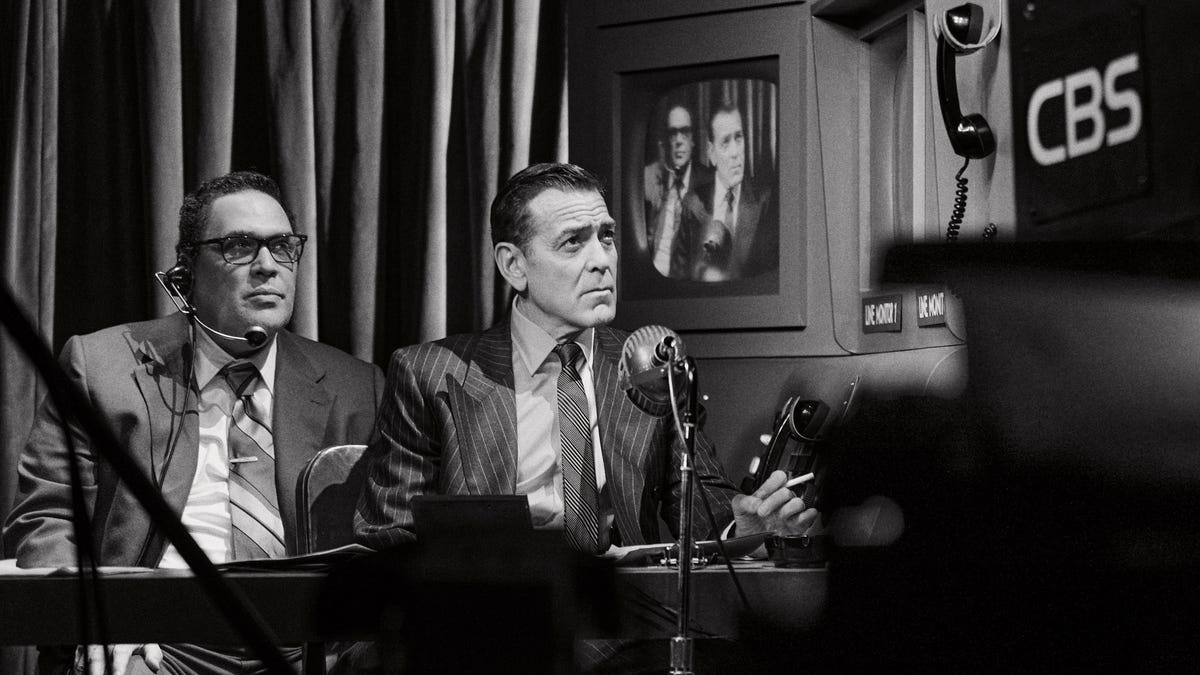NEW YORK — Well, no one could ever accuse him of burying the lede.
George Clooney makes his Broadway debut with “Good Night, and Good Luck,” a well-timed warning about the threat of McCarthyism with all the subtlety of a jackhammer. The play, which opened April 3 at the Winter Garden Theatre, is a near-verbatim recreation of Clooney’s six-time Oscar-nominated film, which was released in 2005 as a response of sorts to the Iraq War.
The actor co-wrote the script with longtime collaborator Grant Heslov and played a supporting role in the movie as CBS News producer Fred Friendly. But here, Clooney has recast himself as journalistic hero Edward R. Murrow, who in the early 1950s defied U.S. Senator Joseph McCarthy and his efforts to stoke anti-communist hysteria through the media.
Clooney acquits himself admirably as Murrow, with deep-set eyes and a furrowed brow that draw you in to the show’s long stretches of TV broadcasts, which are projected in black and white onto myriad screens around the stage. He unflappably captures Murrow’s stoic charm and steady cadence, and his direct-to-camera monologues about courage and conviction earn dutiful applause from the starstruck audience.
The suave A-lister is buttressed by a commendable supporting cast, who make the most of what little they have to work with. Clark Gregg is quietly devastating as downtrodden newscaster Don Hollenbeck, a target of McCarthy’s smear tactics. And “Broad City” mastermind Ilana Glazer is incandescent as the razor-sharp Shirley Wershba, whose hush-hush office romance brings a welcome dose of tenderness to the otherwise dry proceedings.
Where “Good Night” missteps is in its stage adaptation, or rather, the lack thereof. For anyone who has watched the film recently, it’s striking how little has been done to bring this story into a new medium. Clooney and Heslov’s play is an almost word-for-word duplicate of its big-screen predecessor, with little interest in probing Murrow’s interior life or deepening the relationships between characters. The one discernible new scene – a brief exchange between Murrow and Hollenbeck – is primarily in service of a groanworthy punchline about how all the sane people have moved to Europe. (Clooney, for what it’s worth, primarily lives in France these days.)
Sure, you could argue that the movie’s script is unassailable, or that any significant expansions to the story would just be putting a hat on a hat. But the cynic in us suspects a lack of imagination; that Clooney and Heslov were merely too precious and hubristic with their original work, knowing that theatergoers would turn out regardless of what they threw up on stage.
The production is handsomely crafted with elaborate sets by Scott Pask and smartly tailored costumes from Brenda Abbandandolo. Unfortunately, they’re let down by director David Cromer (“The Band’s Visit”), who only fleetingly captures the electricity that makes any good journalism drama tick. Rarely do we ever feel the frenzied rush of bringing a broadcast to air, or the intoxicating mix of panic and suspense as Murrow calmly eviscerates McCarthy on live TV. Instead, most of the behind-the-scenes portions are spent with the cast’s backs to the audience as they stare into monitors. Clooney, meanwhile, is seated catty-corner upstage, his face only fully visible on screens.
Shows like Jamie Lloyd’s “Sunset Boulevard” have made exceptional use of cameras this season to help enrich and complement the narrative. But the ubiquitous walls of video are a crutch in Cromer’s leaden production, creating a static disconnect between Clooney and the audience in moments that should feel the most urgently personal.
The play concludes, like the movie, with a grave word of caution from Murrow about how television can be used to teach and illuminate, but only if people choose to use it to those ends. Clooney and Heslov opt to belabor the message here with a flagrant montage about the history of TV, beginning with Lucille Ball and O.J. Simpson and zipping through “The Jerry Springer Show,” 9/11 terror attacks and Elon Musk appearing to do a Nazi salute.
Clooney’s intentions are completely admirable. At a time when the current administration is suing news networks and banning outlets from the White House press pool, it’s more imperative than ever to not kowtow or fall in line with strong-arming politicians. And yet, “Good Night” only dares to say what we already know, underlined in red ink with umpteen exclamation points.
There’s something smugly satisfied about the whole exercise, which ultimately talks down to its audience and assumes we can’t connect the dots. “Good Night, and Good Luck” aims to be a hard-hitting story about accountability and checks on power, but all that ever comes through is dead air.
“Good Night, and Good Luck” is now playing at the Winter Garden Theatre (1634 Broadway) through June 8, 2025.

Leave a Reply